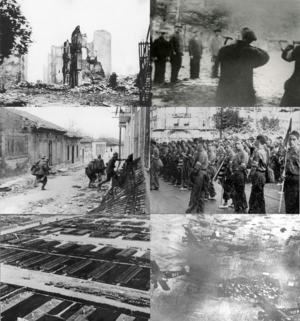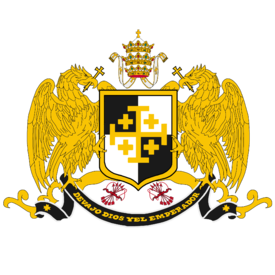Difference between revisions of "Portal:Creeperopolis"
| (15 intermediate revisions by 2 users not shown) | |||
| Line 4: | Line 4: | ||
<div style="width:100%; overflow:hidden; padding:0px; border:solid 0px; background-color:#C5DBF0;">[[File:Cerro verde.jpg|1150px|View of the city of Coatepeque Caldera]]</div> | <div style="width:100%; overflow:hidden; padding:0px; border:solid 0px; background-color:#C5DBF0;">[[File:Cerro verde.jpg|1150px|View of the city of Coatepeque Caldera]]</div> | ||
{{Box-header | {{Box-header | ||
| − | | title= ¡Hola! ¡Bienvenidos a | + | | title= ¡Hola! ¡Bienvenidos a Creeperópolis! |
| editpage= <!-- This data must be the same --> | | editpage= <!-- This data must be the same --> | ||
| noedit= yes | | noedit= yes | ||
| Line 16: | Line 16: | ||
[[File:Coat of Arms of Creeperopolis.png|275px|thumb|right|border|[[Coat of arms of Creeperopolis]].]] | [[File:Coat of Arms of Creeperopolis.png|275px|thumb|right|border|[[Coat of arms of Creeperopolis]].]] | ||
| − | '''Creeperopolis''' ([[ | + | '''Creeperopolis''' ([[Creeperian language|Creeperian]] – [[Creeperian script|Creeperian]]: ''Ծրեեպերօպոլիս''; Creeperian – [[Iberic script|Iberic]]: ''Creeperópolis''; <small>Creeperian pronunciation:</small> {{color|#122080|[kri.peɾˈo.po.lis]}}), officially the '''Holy Traditionalist Empire of Creeperopolis''' (Creeperian: ''Սանտո Իմպերիո Տրադիծիոնալիստա դե Ծրեեպերօպոլիս''; Iberic: ''Santo Imperio Tradicionalista de Creeperópolis''), is the largest nation in [[Sur]] and the 4th largest in the world by land area. Creeperopolis is bordered to the north by the [[Montcrabe|Directorial Republic of Montcrabe]], to the south by the [[Sequoyah|Republic of Sequoyah]] and the [[Senvarian Sea]], to the west by the [[Sea of Castilliano]], the [[Salisford|Kingdom of Salisford]], and the [[El Salvador|Principality of El Salvador]], and to the east by the [[Bay of Salvador]] and the [[Southern Ocean]]. Creeperopolis completely enclaves the client state and religious nation, artificially established by Creeperopolis, known officially as the [[State of the Church|State of the Church]]. Creeperopolis' capital and largest city is [[San Salvador, San Salvador|San Salvador]] located near the center of the country along the southern coast of [[Lake San Salvador]] and west of [[Lake Zapatista]]. As of 2020, Creeperopolis has a population of 532 million, making it the [[List of Countries by Population|most populous nation]] in the [[Portal:Terraconserva|world]]. |
| − | Creeperopolis is the world's second largest economy at ₡94.4 trillion [[Creeperian | + | Creeperopolis is the world's second largest economy at ₡94.4 trillion [[Creeperian colón|colóns]], second only to [[Quebecshire]]. The country continues to struggle with [[Economy of Creeperopolis|massive wealth inequality]], [[Crime in Creeperopolis|rampant crime and crime rates]], [[List of Ongoing Armed Conflicts|four ongoing internal armed conflicts]], [[Corruption in Creeperopolis|rampant government and corporate corruption]], and unprecedented [[Poverty in Creeperopolis|poverty rates of 20–25%]]. The official currency of Creeperopolis is the Creeperian colón and it has been since the relinquishment of the [[Creeperian Dollar]] following the 2003 Creeperian coup d'état. Creeperopolis has been commonly called terms such as a dictatorship, fascist, totalitarian, police state, and banana state, many of which have varying degrees of accuracy. |
<div style="margin-top:1.5ex;text-align:left;margin-right:10px;margin-bottom:4px;">'''[[Creeperopolis|More about Creeperopolis...]]'''</div></div> | <div style="margin-top:1.5ex;text-align:left;margin-right:10px;margin-bottom:4px;">'''[[Creeperopolis|More about Creeperopolis...]]'''</div></div> | ||
<noinclude> | <noinclude> | ||
| Line 32: | Line 32: | ||
<div> | <div> | ||
<div style="background:#1a1a1a;color:#fff;text-align:center">'''Selected Article'''</div> | <div style="background:#1a1a1a;color:#fff;text-align:center">'''Selected Article'''</div> | ||
| − | <div style="padding:1rem">{{Transclude random excerpt | + | <div style="padding:1rem"> |
| − | | 1= | + | {{Transclude random excerpt |
| − | | 2= | + | | 1=Operation Genesis 19:24–25 |
| − | | 3=Creeperian | + | | 2=Romero I of Creeperopolis |
| − | | 4= | + | | 3=Creeperian Civil War |
| + | | 4=2022–23 Liga Imperial | ||
| 5=San Salvador, San Salvador | | 5=San Salvador, San Salvador | ||
| − | | 6= | + | | 6=San Carlos Islands |
| 7=Denshire Massacre | | 7=Denshire Massacre | ||
| − | | 8= | + | | 8=Cooperation and Development Coalition |
| − | | 9=Creeperian | + | | 9=1932 Creeperian general election |
| − | | 10= | + | | 10=Augusto Cabañeras Gutiérrez |
| − | | 11= | + | | 11=Alexander II of Creeperopolis |
| − | | 12= | + | | 12=Alexander, Prince of Extremadura |
| − | | 13= | + | | 13=Maroto Botín |
| − | | 14= | + | | 14=Equipment of the Creeperian Armed Forces |
| − | | 15= | + | | 15=Rubicon War |
| − | | 16= | + | | 16=Free Republic of Noundures |
| − | | 17= | + | | 17=Orlando Pareja Palau |
| − | | 18= | + | | 18=Amèric Perarnau Agué |
| − | | 19=Creeperian | + | | 19=Creeperian Initiative |
| − | | 20= | + | | 20=Himno Imperial |
| − | | 21= | + | | 21=2022 Copa Sur Centennial |
| − | | 22= | + | | 22=2nd Emergency Meeting of the Cooperation and Development Coalition |
| − | | 23= | + | | 23=Creeperian annexation of Navidad and San Juan Diego |
| − | | 24=Creeperian | + | | 24=Creeperian Crusade |
| − | | 25= | + | | 25=Imperial Council v National Council football matches |
| − | | 26= | + | | 26=Pollo Campiña |
| − | | 27= | + | | 27=Siglo XX Games |
| − | + | | 38=2003 Creeperian coup d'état | |
| − | |||
| − | |||
| − | | | ||
| paragraphs=1-2 | files=1 | fileargs=left | more= | errors= |list=List of selected articles}}</div> | | paragraphs=1-2 | files=1 | fileargs=left | more= | errors= |list=List of selected articles}}</div> | ||
</div> | </div> | ||
| Line 102: | Line 100: | ||
<div> | <div> | ||
<div style="background:#1a1a1a;color:#fff;text-align:center">'''Selected Biography'''</div> | <div style="background:#1a1a1a;color:#fff;text-align:center">'''Selected Biography'''</div> | ||
| − | <div style="padding:1rem">{{Transclude random | + | <div style="padding:1rem">{{Transclude random subpage|max=12|subpage=Selected biography}}</div> |
| − | | | ||
| − | |||
| − | |||
| − | |||
| − | |||
| − | |||
| − | |||
| − | |||
| − | |||
| − | |||
| − | |||
| − | |||
| − | |||
| − | |||
| − | |||
| − | |||
| − | |||
| − | |||
| − | |||
| − | |||
| − | |||
| − | |||
| − | |||
| − | |||
| − | |||
| − | |||
| − | |||
| − | |||
| − | |||
| − | |||
| − | |||
| − | |||
</div> | </div> | ||
</div> | </div> | ||
| Line 156: | Line 122: | ||
| 13=Honduran Genocide | | 13=Honduran Genocide | ||
| 14=De-Catholization | | 14=De-Catholization | ||
| − | | 15=Battle of | + | | 15=Battle of Nuevo Xichútepa |
| 16=Battle of the Zapatista River | | 16=Battle of the Zapatista River | ||
| 17=Siege of Almadinat Almuqadasa | | 17=Siege of Almadinat Almuqadasa | ||
| Line 166: | Line 132: | ||
| 23=Creeperian Peasants' War | | 23=Creeperian Peasants' War | ||
| 24=Revolution of 1833 | | 24=Revolution of 1833 | ||
| − | | 25=Christmas | + | | 25=Christmas Coup |
| 26=San Pedro Incident | | 26=San Pedro Incident | ||
| 27=San Salvador del Norte Incident | | 27=San Salvador del Norte Incident | ||
| − | | 28=Salvadoran War | + | | 28=Salvadoran Civil War |
| 29=Papal War | | 29=Papal War | ||
| 30=Creeperian Conflicts | | 30=Creeperian Conflicts | ||
Latest revision as of 04:57, 1 April 2024
¡Hola! ¡Bienvenidos a Creeperópolis!
Creeperopolis (Creeperian – Creeperian: Ծրեեպերօպոլիս; Creeperian – Iberic: Creeperópolis; Creeperian pronunciation: [kri.peɾˈo.po.lis]), officially the Holy Traditionalist Empire of Creeperopolis (Creeperian: Սանտո Իմպերիո Տրադիծիոնալիստա դե Ծրեեպերօպոլիս; Iberic: Santo Imperio Tradicionalista de Creeperópolis), is the largest nation in Sur and the 4th largest in the world by land area. Creeperopolis is bordered to the north by the Directorial Republic of Montcrabe, to the south by the Republic of Sequoyah and the Senvarian Sea, to the west by the Sea of Castilliano, the Kingdom of Salisford, and the Principality of El Salvador, and to the east by the Bay of Salvador and the Southern Ocean. Creeperopolis completely enclaves the client state and religious nation, artificially established by Creeperopolis, known officially as the State of the Church. Creeperopolis' capital and largest city is San Salvador located near the center of the country along the southern coast of Lake San Salvador and west of Lake Zapatista. As of 2020, Creeperopolis has a population of 532 million, making it the most populous nation in the world.
Creeperopolis is the world's second largest economy at ₡94.4 trillion colóns, second only to Quebecshire. The country continues to struggle with massive wealth inequality, rampant crime and crime rates, four ongoing internal armed conflicts, rampant government and corporate corruption, and unprecedented poverty rates of 20–25%. The official currency of Creeperopolis is the Creeperian colón and it has been since the relinquishment of the Creeperian Dollar following the 2003 Creeperian coup d'état. Creeperopolis has been commonly called terms such as a dictatorship, fascist, totalitarian, police state, and banana state, many of which have varying degrees of accuracy.
The Nationalist Creeperian Catholic Royal Initiative and the Pro-Fatherland Front of Unification, more commonly known as the Creeperian Initiative or the Initiative, and abbreviated as the IRCCN y la'FPPU or the IC, is the ruling and sole legal political party of Creeperopolis. The Initiative was established in October 1949 following the conclusion of the Creeperian Civil War by the victorious Catholic Imperial Restoration Council (Imperial Council), merging the various pre-war right-wing political parties into one. As of 2021, the Initiative has more than 137 million members, making it the largest political party in the world. José Sáenz Morales is the current Secretary of the Initiative.
The Initiative was founded by Creeperian Emperor Romero II to unify the various factions of the Imperial Council following the civil war. The parties merged into the Initiative included the National Conservative Party (PCN), the Catholic Royalist Party (PRC), and the Creeperian Pro-Fatherland Front (FPPC), the three political parties which made up the loose Creeperian Conservative Coalition (CCC). Following the Creeperian annexations of Atlántida and Castilliano, the Conservative Party (PC) and the Castillianan Coalition of Autonomous Rights (CCDA) were also merged into the Initiative. Throughout the late-1900s, the party was the dominant force in Creeperian politics, mostly ruling by decree through the Cortes Generales. After the 2003 coup d'état, however, the party's power has been significantly curbed by the Creeperian Armed Forces, which is now the dominant force in politics, due to the party's support of the deposed government of Emperor Alfonso VI. Party leadership was purged following the coup and reorganized to support Emperor Alexander II and Minister of Defense Augusto Cabañeras Gutiérrez. The party now serves a mostly formal role within politics, but continues to hold significant influence in everyday life. Read more...- Mayor of Chalatenango, Schafik Handal López (pictured) was arrested by the National Intelligence Directorate on charges of financially supporting the Deltinian Liberation Army.
- Professor Orlando Pareja Palau of Antonio José Sáenz Heredia University gave a lecture attacking and antagonized the government of Sequoyah, comparing it to Morova.
- The Deltinian Liberation Army accused the 25th Creeperian Army of indiscriminately killing Deltinian civilians. The DLA provided photos but the Ministry of Internal Affairs stated that the photos were clearly photoshopped and some were even photos of dead Creeperian civilians killed by the DLA.
- Hundreds Neo-Saelicists marched in the streets of Sonsonate celebrating the legacy of Castillianan dictator and caudillo Maximiliano Saelices Dávalos who ruled Castilliano from 1823 until 1845. After the march, 5 protestors were arrested on charges of assault while 14 Neo-Saelicists were arrested on charges of assault and conspiracy.
- The United Self-Defense Forces of Creeperopolis captured the Mara Salvatrucha controlled city of Colobador with little opposition.

Minister of Defense Adolfo Cabañeras Moreno reading orders to his officers during the Papal War, 1938.
- ...that Creeperopolis is one of the most densely populated countries in Terraconserva and on the Southern Landmass?
- ...that Creeperopolis uses the Colón as its currency?
- ...that Creeperopolis is currently embroiled in ongoing internal conflicts?
- ...that Creeperopolis is known worldwide for its high quality coffee and sugar?
- ...that Creeperopolis is actively exterminating mosquitos?
- ...that Creeperopolis used to be a republic from 1729-1730?
- ...that Creeperopolis is one of two nations with Spanish as a dominant language?
- ...that Creeperopolis currently constitutes the death penalty for abortion?

The Creeperian Civil War (Creeperian: Գփերրա Ծիվիլ Ծրեեպերիանո / Guerra Civil Creeperiano) was a civil war fought in Creeperopolis from 2 January 1933 and 30 September 1949. The civil war was fought between left and right-wing ideological groups. The left—including liberals, socialists, communists, anarchists, republicans, and political atheists—fought under the banner of the National Council for Peace and Order (National Council) and are often referred to as the Miguelists. The right—including conservatives, traditionalists, fascists, monarchists, and political Catholics—fought under the banner of the Catholic Imperial Restoration Council (Imperial Council) and are often referred to as the Romerists. Additionally, various separatist groups, death squads, independent militia groups, and foreign armies were involved in the civil war, either supporting one of the two councils or fighting independently.
Due to the complex nature and situation of Creeperian politics prior to 1933, the civil war has been viewed in various manners, including as a class struggle, a war of religion, and a struggle between fascism and communism. The Second Parliamentary Era of Creeperopolis was marked by internal violence between political factions and their militias, multiple attempted coups d'état and self coups, various large-scale protest movements, and general instability. The death of Emperor Adolfo IV on 2 January 1933 triggered the civil war, as his two surviving sons, Princes Romero and Miguel, both of whom had two vastly different political views, declared themselves as Adolfo IV's successor as emperor. Romero I was supported by the right-wing Creeperian Conservative Coalition (CCC) while Miguel VII was supported by the left-wing People's Social Coalition (CSP). War began after military factions loyal to both emperors skirmished in San Salvador del Norte; the skirmish fractured the military in half along ideological lines. Read more...










